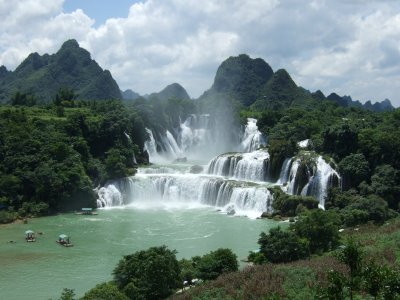Vietnam will invest VND1,931 trillion (US$94.2 billion) between 2011 and 2030 in an effort to make tourism the nation’s key sector by 2020.
It is estimated that 8-10 percent of the investment will be allocated from the state budget, while the rest comes from private sector. The plan aims to build a “developed” tourism industry in Vietnam by 2030.

Ban Gioc Waterfall, a priority project in Vietnam’s tourism development plan, will receive US$500 million in new investment
Under a tourism development project approved by Vietnamese Prime Minister Nguyen Tan Dung Tuesday (January 22), the country will first use the money to upgrade infrastructure, develop competitive tourism products and improve human resources in the industry and protect the environment of the tourist spots.
The investment will be put into the countries’ major tourist spots, especially those in rural and border regions and islands.
Among eight priority sites is Ban Gioc in the mountainous area in northern Vietnam, over which both Vietnam and China claim sovereignty, and which will receive a total investment of $500 million from the project between 2011 and 2030.
Ban Gioc Falls in Cao Bang Province, which the Chinese call Detian Falls, is situated on the border between Vietnam and China.
It is one of the world’s largest falls lying in the border of the two countries together with Brazil and Argentina’s Iguazu, Zambia and Zimbabwe’s Victoria and Canada and the United States’ Niagara.
Under the 1999 Viet Nam-China Treaty on Land Borderline, Vietnam has sovereignty over the waterfall’s tributary and the large waterfall is shared by the two countries.
But the sovereignty issues concerning the falls made headlines in the local media reports two years ago after some websites such as Australian news website news.com.au captioned the waterfall’s location with China only, unlike the cases of Iguazu, Victoria and Niagara, which were captioned with the name of both countries they are located in.
Vietnam government in 2007 had approved a VND2.4-trillion plan to develop infrastructure at the waterfall site from 2008-2020 in an effort to boost the number of tourists to one million in 2020.
According to the latest statistics from Cao Bang Province Department of Culture, Sports and Tourism, the site attracts around 30,000 tourists a year.
Vietnam’s leading travel agency Saigontourist started construction on a four-star resort near the famous waterfall early last December, with the total investment of VND170 billion. The resort is scheduled to open by the end of this year.
Vietnam expects a year-on-year foreign tourist increase of 5.2-8.4 percent by 2030 while domestic tourist arrivals are estimated to surge by a yearly 4.8 percent on average, according to the plans for the recently-approved project.
Vietnam will invest VND1,931 trillion (US$94.2 billion) between 2011 and 2030 in an effort to make tourism the nation’s key sector by 2020.
It is estimated that 8-10 percent of the investment will be allocated from the state budget, while the rest comes from private sector. The plan aims to build a “developed” tourism industry in Vietnam by 2030.
Under a tourism development project approved by Vietnamese Prime Minister Nguyen Tan Dung Tuesday (January 22), the country will first use the money to upgrade infrastructure, develop competitive tourism products and improve human resources in the industry and protect the environment of the tourist spots.
The investment will be put into the countries’ major tourist spots, especially those in rural and border regions and islands.
Among eight priority sites is Ban Gioc in the mountainous area in northern Vietnam, over which both Vietnam and China claim sovereignty, and which will receive a total investment of $500 million from the project between 2011 and 2030.
Ban Gioc Falls in Cao Bang Province, which the Chinese call Detian Falls, is situated on the border between Vietnam and China.
It is one of the world’s largest falls lying in the border of the two countries together with Brazil and Argentina’s Iguazu, Zambia and Zimbabwe’s Victoria and Canada and the United States’ Niagara.
Under the 1999 Viet Nam-China Treaty on Land Borderline, Vietnam has sovereignty over the waterfall’s tributary and the large waterfall is shared by the two countries.
But the sovereignty issues concerning the falls made headlines in the local media reports two years ago after some websites such as Australian news website news.com.au captioned the waterfall’s location with China only, unlike the cases of Iguazu, Victoria and Niagara, which were captioned with the name of both countries they are located in.
Vietnam government in 2007 had approved a VND2.4-trillion plan to develop infrastructure at the waterfall site from 2008-2020 in an effort to boost the number of tourists to one million in 2020.
According to the latest statistics from Cao Bang Province Department of Culture, Sports and Tourism, the site attracts around 30,000 tourists a year.
Vietnam’s leading travel agency Saigontourist started construction on a four-star resort near the famous waterfall early last December, with the total investment of VND170 billion. The resort is scheduled to open by the end of this year.
Vietnam expects a year-on-year foreign tourist increase of 5.2-8.4 percent by 2030 while domestic tourist arrivals are estimated to surge by a yearly 4.8 percent on average, according to the plans for the recently-approved project.



Comments